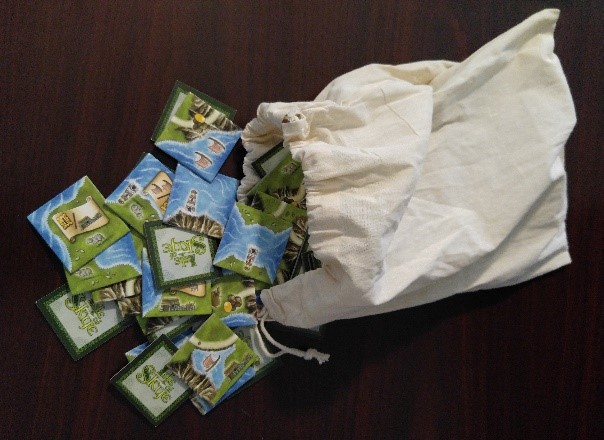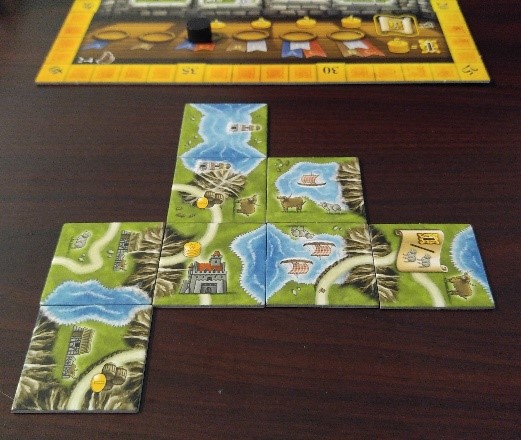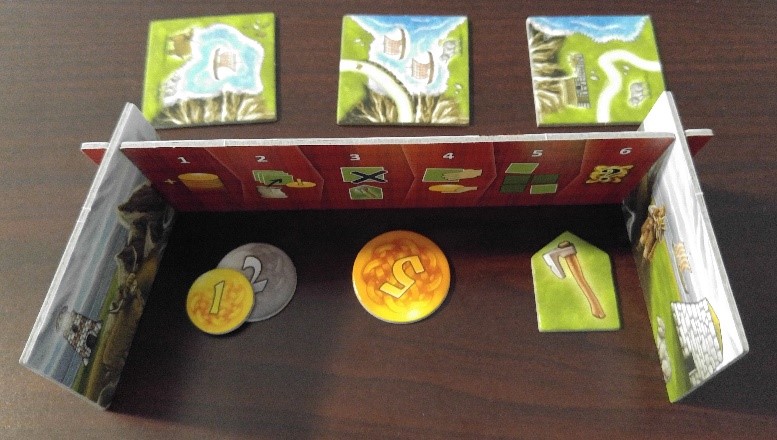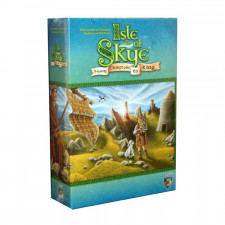Isle of Skye: From Chieftain to King Review
on Aug 10, 2016
Long ago in Scotland, brave chieftains battled each other over land. They fought over the lush hills, craggy mountains, sandy beaches, cows, sheep, and… kegs that gave you a dollar if they connected back to your castle along a road. Okay, so, maybe Isle of Skye isn’t the most historically accurate account of Scottish history, but it’s certainly an amusing alternative of fierce leaders vying for control over land through clever bidding and sensibly pricing land.
Isle of Skye is the most recent winner of the Kennerspiel des Jahres – the German award for connoisseur/enthusiast game of the year. Designers Andreas Pelikan and Alexander Pfister are on a roll with their second consecutive win (last year was Broom Service). Mechanically, Isle of Skye is a combination of tile-laying and bidding/valuation. In other words, it’s the lovechild of Carcassonne and Castles of Mad King Ludwig, but without its mother’s meeple placement or father’s differently-shaped-rooms spatial/puzzle aspect. Err… maybe I should explain it without a weird board game lineage metaphor.

Each player draws three tiles from the bag. (Props to Mayfair for including this in the box, but it’s disappointingly not plaid.) Of those three tiles, you will set a price two of them and axe the other, which means it will get tossed back into the bag. Going around the table, each player may purchase one tile from their opponents. After everyone has done that, you pay the bank for any tiles left in front of you and put those into your own clan territory, building according to your typical matching-sides rules. This is where the valuation part of the game comes in. You may be trying to price things at that Goldilocks just right price so that you can keep that perfect ship tile for your own area or make some money off of an opponent who desperately needs just one more cow to complete a set. However, try to exploit your opponents too much and you’re might end up losing all that cash.

Although the above interactions are interesting enough, one of the best parts of the game is its dynamic scoring system. Each game has four scoring tiles set out at the beginning, however not all tiles will score for each round. For example, tile B scores for round 1, then A and C for round 2, then B and D for round 3, and so on. This allows you to think about which tiles are most valuable to you (and your opponents) each round and manipulate your board accordingly. This scoring is fairly unique among games and one that I’m really fond of. It rewards you for both tactical and strategic play. After five rounds, you finish up normal scoring and add any endgame bonuses you may have built, and that’s it.
Given how smoothly these mechanisms work together, it is surprising no one has made this game before now. Plenty of games have tried to reproduce the simplicity and appeal of Carcassonne’s tile laying, but few have succeeded. As a huge fan of Carcassonne, this is one of the things that most draws me to Isle of Skye. As mentioned above, there is a spatial/puzzle aspect to the game, but given that all the tiles are square and there are only a few constraints to consider, allowing you to focus on how best to rotate your tile for points instead of figuring out how to fit a rectangle piece next to an L-shape next to an oval.

The other half of the game, the tile bidding/valuation, is something that works better in concept than practice for me. It’s hard to know exactly how to value your tiles even if you spend a ton of time looking at everyone else’s board, then the round scoring, then min/max your points given the array of tiles that are out there, etc. That level of number-crunching isn’t fun and, if someone in your group is prone to that playstyle, it can significantly drag down the otherwise snappy game length of 45-60 minutes. And this nuisance is only increased by more players in a game. So although the game plays well with all player counts, it is more cutthroat with fewer players since you can track others’ boards quicker and easier. Moreover, at a certain point, you have to accept that you cannot possibly know exactly which tiles your opponents are eyeing and for how much and to just shoot from the kilt in your pricing.
Overall, Isle of Skye is a well-design, relatively light, but not brainless, game. Despite its somewhat prestigious award, I’m not sure how much the game will blow you away. It’s not going to be one of those nail-biting games that erupts in uproarious victory with memorable callbacks of “Hey, remember when you set the bid at $5 and I had exactly that much? Ha ha! Good times.†However, Isle of Skye does what it does well enough and its weight and length make it a convenient start-of-the-night or after-dinner game. It’s certainly not an albatross to have on your shelf and would be an especially good pick for gamers who may be looking to add a solid Eurogame to their budding collection.

 Customer Support
Customer Support  Subscribe
Subscribe 




 Account
Account  Wishlist
Wishlist 

